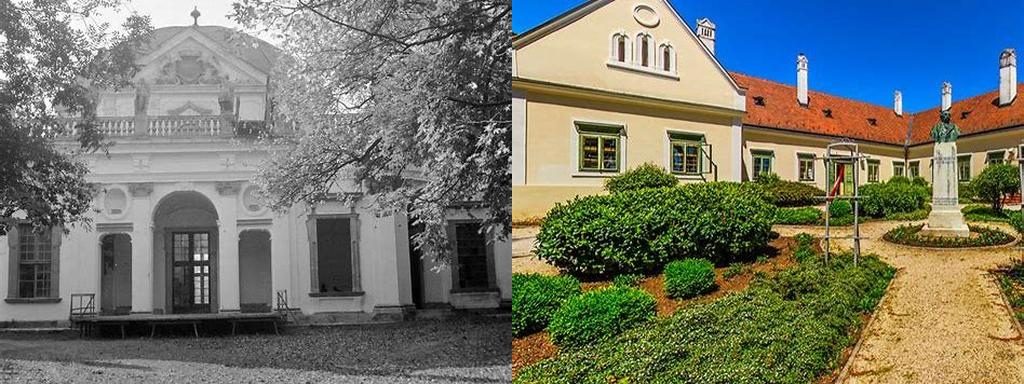
Bártfay-kúria in Kisrozvány is one of those places that feels somehow distilled from the essence of what makes a rural Hungarian manor house so memorable. Tucked away in the peaceful open spaces of northeastern Hungary, this elegant mansion stands quietly, halfway between the world-weary charm of yesteryear and the gentle persistence of a living village landscape. Visiting it means embracing slow mornings, the intricate history scribbled into plaster and wood, and a sense of encounter with an undemanding past—no velvet ropes, no crowds, just you, the faded grandeur, and the hidden stories beneath each floorboard.
Rise early in Kisrozvány and you’ll find the pale sunlight slanting off the old lime-washed walls of the Bártfay Mansion. If you’ve seen stately homes in Budapest or elsewhere, this one will surprise you with its humility and the kind of lived-in authenticity that’s hard to find now. The Bártfay family, once important local landowners, built their manor in the early 1800s—and echoes of those days still linger. The air hums with birdsong, the shadows of chestnut trees flicker across cracked flagstones, and every window—framed by handcarved shutters—seems to guard a secret or two. It isn’t extravagant, but something about its proportions and its landscape placement feels just right, gently inviting you to slow your steps and listen.
The house itself is a late classicist gem, its facade marked by subtle pilasters and an inviting porch that feels designed for long afternoons of conversation. While grand manors elsewhere parade their opulence, the Bártfay-kúria is touchingly modest, perhaps reflecting the true temperament of Northern Hungary. Step inside—often, if you visit on a quiet day, there will be a friendly local caretaker eager to speak about the old days and maybe share a few legends. You might stand in the central hall and feel the hush of centuries, broken only by the sound of floorboards set to their own stubborn melodies.
Apart from the architecture and the quietly beautiful grounds, visitors are often most struck by the personal histories embedded throughout. The Bártfay family, particularly Ferenc Bártfay, was deeply involved in local community life. In the mid-19th century, Ferenc was known for supporting the 1848 Hungarian Revolution, and local lore has it that wandering revolutionaries—even Lajos Kossuth himself—once found shelter here. These stories are not just pageantry; they’re folded into the everyday fabric of Kisrozvány. If you ask around in the village, someone might still suggest that the oaks behind the house once hid secret meetings, or that the dusty old library shelves know more than they reveal.
Wander outside, and you’ll notice the grounds are untamed in a way lusher than any manicured garden. Ancient walnut and chestnut trees preside over the house, and behind, fields stretch towards the horizon, punctuated by a crumbling stone barn—the kind that offers a moment for a photograph (or two) under a cobalt-blue sky. You’re just as likely to see a retired villager tending to the overgrown roses as to stumble upon an artist sketching beneath the eaves. Unlike tourist-slick estates, here you might actually feel compelled to pause, breathe, and wonder whose footsteps you’re following.
What’s perhaps most surprising is the house’s present-day life. Over the years, the Bártfay Mansion has served as a noble residence, a communal gathering spot, and occasionally even as a village school. Today, the building’s layers remain visible—faint chalk markings from lessons linger on walls, and old furnishings sit side-by-side with modest newer touches. Sometimes, if you visit in summer, the courtyard will fill with music or laughter from one of the village’s impromptu festivals. It’s not a museum—it’s something truer, something porous to the lives of people who still cradle its history, whether they know it or not.
Walking around the mansion, it’s easy to realize you’re standing in a place where the passage of time is palpable. Yet the atmosphere never feels heavy; curiosity and comfort live side by side. After a visit to Bártfay-kúria, you may catch yourself remembering small details: the sunlit dust in the stairwell, the wide, battered front door that seems to breathe slightly as it soaks in the afternoon, the distant hum of bees in the warm air. If your travels ever take you through Kisrozvány, give yourself the gift of a couple quiet hours here—bring a notebook or a book, or just yourself. Sometimes, the best history lessons come not from museums, but places just like this, where memory lingers in the morning light.





